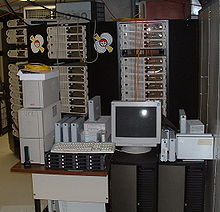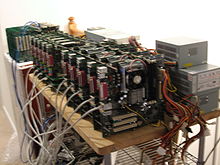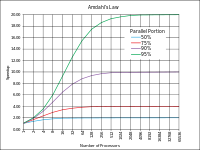- Beowulf cluster
-
 The Borg, a 52-node Beowulf cluster used by the McGill University pulsar group to search for pulsations from binary pulsars
The Borg, a 52-node Beowulf cluster used by the McGill University pulsar group to search for pulsations from binary pulsars
A Beowulf cluster is a computer cluster of what are normally identical, commodity-grade computers networked into a small local area network with libraries and programs installed which allow processing to be shared among them. The result is a high-performance parallel computing cluster from inexpensive personal computer hardware.
The name Beowulf originally referred to a specific computer built in 1994 by Thomas Sterling and Donald Becker at NASA. The name comes from the main character in the Old English epic poem Beowulf, which was bestowed by Sterling because the titular hero is described as having "thirty mens' heft of grasp in the grip of his hand".[1]
There is no particular piece of software that defines a cluster as a Beowulf. Beowulf clusters normally run a Unix-like operating system, such as BSD, Linux, or Solaris, normally built from free and open source software. Commonly used parallel processing libraries include Message Passing Interface (MPI) and Parallel Virtual Machine (PVM). Both of these permit the programmer to divide a task among a group of networked computers, and collect the results of processing. Examples of MPI software include OpenMPI or MPICH. There are additional MPI implementations available.
Beowulf systems are now deployed worldwide, chiefly in support of scientific computing.
Contents
Development
 An illustration of the headless and diskless nature of a beowulf cluster, in the TinyHPC cluster [2]
An illustration of the headless and diskless nature of a beowulf cluster, in the TinyHPC cluster [2]
The following is the definition of a Beowulf cluster from the original "how-to", which was published by Jacek Radajewski and Douglas Eadline under the Linux Documentation Project in 1998.[3]
Beowulf is a multi-computer architecture which can be used for parallel computations. It is a system which usually consists of one server node, and one or more client nodes connected together via Ethernet or some other network. It is a system built using commodity hardware components, like any PC capable of running a Unix-like operating system, with standard Ethernet adapters, and switches. It does not contain any custom hardware components and is trivially reproducible. Beowulf also uses commodity software like the FreeBSD, Linux or Solaris operating system, Parallel Virtual Machine (PVM) and Message Passing Interface (MPI). The server node controls the whole cluster and serves files to the client nodes. It is also the cluster's console and gateway to the outside world. Large Beowulf machines might have more than one server node, and possibly other nodes dedicated to particular tasks, for example consoles or monitoring stations. In most cases client nodes in a Beowulf system are dumb, the dumber the better. Nodes are configured and controlled by the server node, and do only what they are told to do. In a disk-less client configuration, a client node doesn't even know its IP address or name until the server tells it.
One of the main differences between Beowulf and a Cluster of Workstations (COW) is that Beowulf behaves more like a single machine rather than many workstations. In most cases client nodes do not have keyboards or monitors, and are accessed only via remote login or possibly serial terminal. Beowulf nodes can be thought of as a CPU + memory package which can be plugged in to the cluster, just like a CPU or memory module can be plugged into a motherboard.
Beowulf is not a special software package, new network topology, or the latest kernel hack. Beowulf is a technology of clustering computers to form a parallel, virtual supercomputer. Although there are many software packages such as kernel modifications, PVM and MPI libraries, and configuration tools which make the Beowulf architecture faster, easier to configure, and much more usable, one can build a Beowulf class machine using standard Linux distribution without any additional software. If you have two networked computers which share at least the
/homefile system via NFS, and trust each other to execute remote shells (rsh), then it could be argued that you have a simple, two node Beowulf machine.Operating systems
Currently there are a number of Linux distributions, and at least one BSD, that are designed for building Beowulf clusters. These include:
- MOSIX, geared toward computationally intensive, IO-low, applications
- ClusterKnoppix, based on Knoppix
- Kerrighed
- Rocks Cluster Distribution
- Scyld
- DragonFly BSD
- Quantian, a live DVD with scientific applications, based on Knoppix and ClusterKnoppix
A cluster can be set up by using Knoppix bootable CDs in combination with OpenMosix. The computers will automatically link together, without need for complex configurations, to form a Beowulf cluster using all CPUs and RAM in the cluster. A Beowulf cluster is scalable to a nearly unlimited number of computers, limited only by the overhead of the network.
Provisioning of operating systems and other software for a Beowulf Cluster can be automated using software, Open Source Cluster Application Resources (OSCAR) for example. OSCAR installs on top of a standard installation of a supported Linux distribution on a cluster's head node.
See also
- Alewife (multiprocessor)
- Grid computing
- Kentucky Linux Athlon Testbed
- Platform LSF
- Portable Batch System
- SLURM
- Stone Soupercomputer
- Sun Grid Engine
References
- ^ Paul McFedries (2000-12-07). "Beowulf cluster". Word Spy. http://www.wordspy.com/words/Beowulfcluster.asp. Retrieved 2011-06-14.
- ^ "TinyHPC" (PDF). http://www.mukarramtahir.com/EARLY_DRAFT_HPCClusterPaper.pdf. Retrieved 2011-06-14.
- ^ "original Beowulf HOWTO". Ibiblio.org. http://www.ibiblio.org/pub/linux/docs/HOWTO/archive/Beowulf-HOWTO.html. Retrieved 2011-06-14.
External links
Parallel computing General 
Levels Threads Theory Elements Coordination Multiprocessing · Multithreading (computer architecture) · Memory coherency · Cache coherency · Cache invalidation · Barrier · Synchronization · Application checkpointingProgramming Hardware Multiprocessor (Symmetric · Asymmetric) · Memory (NUMA · COMA · distributed · shared · distributed shared) · SMT
MPP · Superscalar · Vector processor · Supercomputer · BeowulfAPIs Ateji PX · POSIX Threads · OpenMP · OpenHMPP · PVM · MPI · UPC · Intel Threading Building Blocks · Boost.Thread · Global Arrays · Charm++ · Cilk · Co-array Fortran · OpenCL · CUDA · Dryad · DryadLINQProblems Embarrassingly parallel · Grand Challenge · Software lockout · Scalability · Race conditions · Deadlock · Livelock · Deterministic algorithm · Parallel slowdown
Categories:- Cluster computing
- Parallel computing
- Job scheduling
- NASA technology spinoffs
- Unix software
Wikimedia Foundation. 2010.


